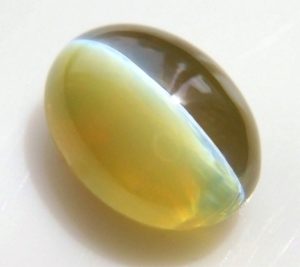Cats Eye Stone: A Complete Guide on Cat's Eye Gemstone
September 29, 2023
I have often come across the term ‘cat’s eye‘ – you may have too – in relation to certain gemstones. Maybe you have one or more of them in your jewellery wardrobe so know exactly what they look like and how they display their special optical phenomena but if you do not know them I’ll do my best to describe them.
First, then you have to think of the slit eye of a cat or the technical French term chatoyancy – ‘oeil de chat’ – that translates as ‘eye of the cat”. In a gemstone, this slit eye feature is caused by light reflecting off the stone’s microscopic natural needles, channels or fibres binding them together into a thin streak.
The cut is all important here because a faceted gem will not display the cat’s eye. Rather, for the full effect of the cat’s eye feature the stone must be cut in cabochon with the base parallel to those inclusions and polished so that the cat’s eye appears to glide over the rounded surface when the stone is rotated.
The most famous and valuable cats eye stone is the chrysoberyl cat’s eye and, in fact, it is the only gem that can be described that way or carries that privileged distinction because all other cat’s eye stones require additional variety designation, e.g.
- Cat’s eye apatite
- Cat’s eye tourmaline
- Cat’s eye quartz
- Cat’s eye jade, etc.
The cat’s eye phenomenon, therefore, can only occur when those inclusions in the stone are present whereas in any other gemstone those obvious inclusions could be seen as flaws that would then diminish the gem’s value. But these inclusions – needles, fibres, tubes or channels – are what make a cat’s eye gemstone such a fun gem that seems to be looking back at us with its beautiful, fascinating eyes.
And, like many other gemstones, particularly those that are colour-change, the lighting – whether natural or artificial – is essential for it is the light that changes the colour and in the cat’s eye gem it is the light that brings those needles, etc into the straight line that glides over the stone’s polished surface to resemble the optical illusion of the cat’s eye.
The Chrysoberyl Cats Eye Stone
Chrysoberyl is an ancient mineral that registers 8.5 on the Mohs Scale and perhaps, like jade thousands of years ago, was used by those prehistoric cultures to make weapons and tools of all descriptions or types.
It belongs to the same family as the rare and extremely beautiful Alexandrite that exhibits different colours in natural and artificial lights thereby making the cat’s eye Alexandrite or the Alexandrite cat’s eye a most desirable gemstone even for the most discerning tastes.
I would even go so far as to say, the Alexandrite cat’s eye is the perfect gemstone for the woman who has everything.
Cats Eye Stone Colour
Colour is as important in the cats eye stone as any other inclusion-free gemstone and the brighter the colour the more expensive the gem of whatever variety but the best and foremost colour for a cats eye gemstone of any type is yellow, thus making the golden chrysoberyl the most famous species.
This is not really surprising when you consider the colour of a real cat’s eye or a tiger’s eye; hence the really interesting and inexpensive golden or golden-brown Quartz cat’s eye tiger eye.
So, if your favourite colour is yellow, a cats eye stone might just be just exactly what you’re looking for to spruce up your jewellery wardrobe or impress your friends when the stone looks up at them as they look at it. Yellow, of course, is not the only colour because the cat’s eye occurs in many different gems and therefore, depending on the colour of the host stone, it also occurs in pinks, greens, reds, and blues: colours to suit every taste or preference.
Gems that display the Cat’s Eye Phenomenon
You might be surprised, as I was, to learn that there are more than 30 gems that show the optical illusion of cat’s eye. They include:
- Apatite
- Tourmaline
- Beryl, Zoisite
- Zircon, Peridot
- Diopside
- Chrome Diopside
- Kunzite, Nephrite (Jade)
- Quartz
And of course Alexandrite, the most expensive of which on today’s market being the Alexandrite cat’s eye with the Quartz tiger eye cat’s eye being the least expensive thus giving you a big range to choose from if a cat’s eye gemstone is in your future.
To fully appreciate them, though, you need to see them in person because words cannot adequately describe the amazing optical illusion of a cat’s eye looking back at you while you gaze at it.
Therefore, I strongly suggest you visit LL Private Jewellers to see them for yourself and enjoy this phenomenal experience.
For more information about cats eye stone please contact LL Private Jewellers at 604-684-6343.
Check Out Our Most Popular Jewelry Collections
